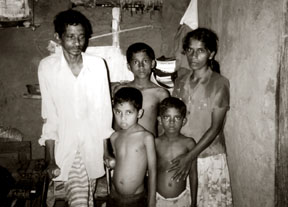|
observer |
|
|
|
|
|
OTHER LINKS |

|

|

|
On the borders of the North-South conflictA farmer family battles killer elephants and more...
Perhaps there are no apt words to describe the plight of brave farmer P Jayasena 42, his wife, and three children who live in the elephant invested jungle in the village of Ethakada, bordering Vavuniya, which is also the haunt of LTTE terrorists.
For, stories are raw and rife of murderous elephants in this god-forbidden part of the world which kill farmers at harvest time and destroy their houses only to consume the stored grain. But, the elephant was torturous enough not to kill Jayasena when he did all else to him and his family. The Jayasena family live in the little part of their wattle and daub home, left behind by the rogue elephant. A Sri Lankan domiciled in Ontario, Canada, Mrs Beatrice Goonasekara has funded the building of a new home for this family, on the same spot with Rs 300,000 ($1,210), and the work is going on. But, Jayasena faces a much more complex problem, being a threat to his life, if his long infected foot is not amputated. A smash under Jayasena's foot (described as gal thaluma, in Sinhala by him) got infected and he has lived with it for over four years. Six operations he underwent in the nearest state hospitals has not healed the wound. Jayasena politely refused to keep his foot on the ground for our entertainment, for the pain he felt was too intense. He could not pose outside his room for a photograph as it began raining and his leg had to be kept dry. The head of this family has no heart to leave behind his three children and enter hospital for the required amputation, for the children fear that when their father is out of home, the elephant will come again. In ancient Sri Lanka, a village comprised a group of thatched huts of people who lived nearby, for one another's protection. But, even today, by some stroke of ill-fortune, people in the furthest parts of rural Sri Lanka live in isolation, the closest family, being miles away, and the Jayasena family complies with this scattered order norm.
Jayasena understood that the longer he delays his amputation, the further the infection will run, and the higher the amputation will have to be done. He understood that he is growing weaker and thinner by the day. Back home, merciful people enlightened us that the immediate need of this young family is the restoration of the health of their head, Jayasena. For, there are ayurvedic doctors, who have saved limbs, when all else was given up, well meaning people said. Philanthropist Mahinda Karunaratne 74, who founded the Karuna Trust visited Jayasena and his family last week on his many missions to the borders of Madawatchchiya, where, schools, temples, houses and the like are being built, and transferred without obligation on the part of recipients. Karunaratne has been urged to go back and bring Jayasena to Colombo, for treatment. Jayasena has already been contacted through the Grama Sevaka (village headman) of the area. Journalists and others at Lake House who know Karunaratne are in the process of raising Rs 100,000 towards treating Jayasena, close to Colombo. If more money is collected among us, it will be handed over to the Karuna Trust. Until then, Jayasena's faithful wife, Chitra Kumari will continue being the bread winner. She does kuli veda, meaning odd jobs. For, with the man disabled and weak, no family-benefiting cultivation takes place. Son Udaya Kumara is 12 years old and Supun Bandara 8. Saumiya Kumari, their daughter is 6. These bright eyed children's eyes seemed to glisten even more, when this photograph was taken in near total darkness, for their source of night light, their (kuppie pana in Sinhala) translated colloquially - the bottle lamp, could not be found. The three children attend school which is not far away, applying the norms of rural Sri Lanka. They have informed the Department of Wild Life of the elephant attack, and have been given two explosives, which make a big noise and frighten elephants away. But, there are cases, where terrified villagers, when challenged by elephants, could not remember that they had to throw the unbuttoned explosive, and were blown up. The Sinhalese villagers and home guards are building bunkers here in fear of the frequenting raids and killings of civilians by the LTTE militants, operating on this border divide. Home guards are commonplace, here. Rice cultivation is carried out only under the protection provided by the armed forces and the home guards. It seems as if the LTTE in these borders, prefers killing home guards, to the army or police. The reasons are manifold. Among them are, that the home guards are made up of peasants of the village. Home guards have to work 12 hours. This means they have hardly any time for cultivating the fields of their village. Less cultivation done, is a blow to the economy, which the LTTE targets. More home guards killed means, the more the tendency of people to pull south making it all the easier for the LTTE to walk and walk southwards. But, this is not the appropriate place, to mention their ulterior motive. Needless to say, that every killing by the LTTE of people in government held land, necessitates the government to pay compensation. |










